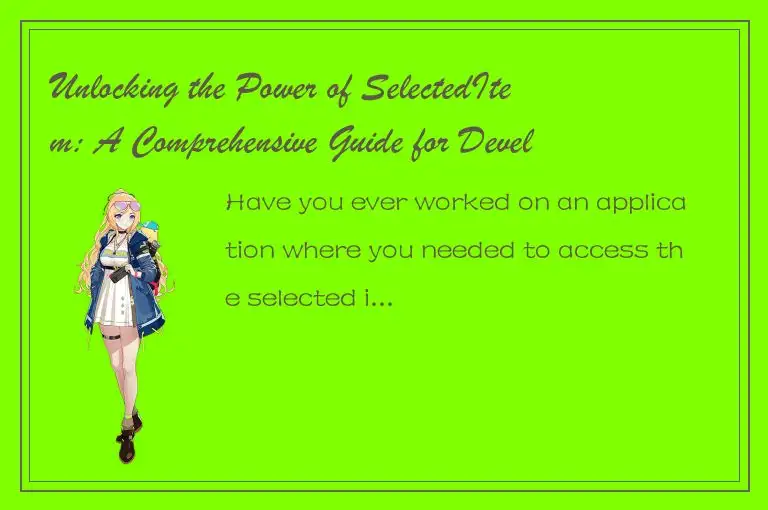Have you ever worked on an application where you needed to access the selected item of a list or data grid? It’s a pretty common scenario in application development, and it can be frustrating when you can’t get the functionality you need out of the selected item. But fear not, for there is a solution: the SelectedItem function. In this guide, we’ll go over everything you need to know about the SelectedItem function and how to use it to its fullest potential.

What is SelectedItem?
At its core, SelectedItem is a function that allows you to access the currently selected item in a list or data grid. It’s an essential tool for developers who need to retrieve the data from the selected item and then perform some kind of action on it. SelectedItem is used in many different scenarios throughout application development, from filtering data to generating reports to populating other UI elements.
Types of Data Grids
Before we dive into how SelectedItem works, it’s important to understand the different types of data grids that you might encounter in your development projects.
1. Single-Select Data Grid: As the name suggests, this type of data grid only allows the selection of one item at a time. This makes it easier to work with SelectedItem, as you know that only one item will ever be selected at any given time.
2. Multi-Select Data Grid: In contrast, a multi-select data grid allows for the selection of multiple items at the same time. This adds an extra layer of complexity to using SelectedItem, as you need to be able to handle multiple items being selected simultaneously.
How SelectedItem Works
Now that you understand the different types of data grids, let’s take a closer look at how SelectedItem works.
When an item in a data grid is selected, the data associated with that item is stored in the SelectedItem variable. SelectedItem is essentially a reference to the data object rather than the UI element that represents the item. This means that you can use SelectedItem to access the data associated with the selected item and then modify it or perform some kind of action.
To use SelectedItem, you first need to check that an item has actually been selected. You can do this by checking the SelectedIndex property of the data grid. If the SelectedIndex is greater than or equal to zero, that means an item has been selected and you can access its data using SelectedItem.
Here’s an example of how to use SelectedItem in a single-select data grid:
private void DataGrid_SelectionChanged(object sender, SelectionChangedEventArgs e)
{
if (DataGrid.SelectedIndex >= 0)
{
//Get the data associated with the selected item
var selectedData = DataGrid.SelectedItem;
//Do something with the selected data
//...
}
}
And here’s an example of how to use SelectedItem in a multi-select data grid:
private void DataGrid_SelectionChanged(object sender, SelectionChangedEventArgs e)
{
//Get the data associated with each selected item
foreach (var selectedData in DataGrid.SelectedItems)
{
//Do something with the selected data
//...
}
}
As you can see, using SelectedItem is relatively straightforward. The most important thing is to check that an item has actually been selected before attempting to access its data. Once you’ve done that, you can use SelectedItem to retrieve the data object and perform any necessary actions on it.
Common Uses for SelectedItem
Now that you understand how SelectedItem works, let’s take a look at some of the most common scenarios where you might use it.
1. Filtering Data: SelectedItem can be used to filter data based on the selected item in a data grid. For example, if you have a list of products and you want to filter the products based on the category of the selected item, you can use SelectedItem to retrieve the category and then filter the products accordingly.
2. Populating Other UI Elements: SelectedItem can be used to populate other UI elements based on the data associated with the selected item. For example, if you have a data grid of customers and you want to display the customer’s information in a separate form when they are selected, you can use SelectedItem to retrieve the customer data and then populate the form fields.
3. Generating Reports: SelectedItem can be used to generate reports based on the selected item in a data grid. For example, if you have a data grid of sales orders and you want to generate a report of all sales orders for a particular customer, you can use SelectedItem to retrieve the customer data and then generate the report based on that data.
Conclusion
SelectedItem is an essential tool for developers who need to access the data associated with the selected item in a data grid. By understanding its functionality and how to use it, you can unlock a world of possibilities for your application development projects. Whether you’re filtering data, populating other UI elements, or generating reports, SelectedItem is a powerful tool that can help make your development process more efficient and effective.




 QQ客服专员
QQ客服专员 电话客服专员
电话客服专员